
|   |

|   |
 e-mail: leelakaverivenkat@gmail.com The festival sun rises again at Konark Photos courtesy: Odisha Tourism December 19, 2022 After two torrid Covid years, followed by being rained out last year, the sun rose again for the Konark festival, attracting a handsome turnout. In a world driven by the sense of isolation on the one hand and dissension on the other, starting the festival with Malaysia's Datuk Ramli Ibrahim's Sutra Foundation presenting Jaya Ram in the Odissi style, for me as a dance writer, represented a symbolism demonstrating the healing power of culture as soft power. Here was India's famous epic, the Ramayana, (which, over time, has caught the creative imagination of artistes in several parts of South East Asia) in a production fashioned through an Indian/Malaysian bonding, comprising Guru Gajendra Kumar Panda's concept and original dance composition, presented by Sutra artistes of Malaysia, under the artistic direction of Ramli Ibrahim - both artistes sharing the background of having been trained in the Debaprasad Odissi school, under the late Guru. 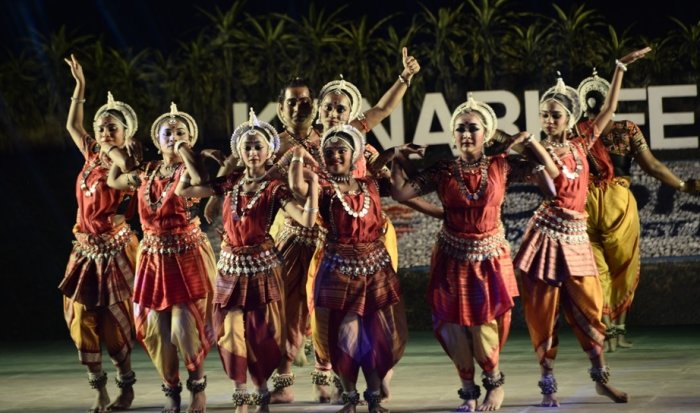 Sutra Dance Theatre But for many, this Odisha/Malaysia association, with Ramli having being awarded all the top honours of the governments of Odisha and India for ensuing permanent space for Odissi in a country where this dance is not part of the culture, is now old hat. As a production, Jaya Ram, dipping into Odisha's indigenous folk and tribal culture (in the mode of Guru Debaprasad), with a predominant influence of people's traditions from Ganjam (thanks to a long association with the renaissance person, late Dr. Dinanath Pathi) the evening, for this critic, was a disappointment. It failed to project the best of what one has associated with Ramli Ibrahim and his troupe. For one thing, his group, unlike the made-to-order slim dancers moving with grace and phenomenal group discipline, seemed to have changed into a motley group, in all sizes and professional levels. Merely dividing the group between benevolent and malefic roles, did not satisfy aesthetic standards. To keep in touch with roots of a culture and being enthused by a Ram Leela performance in a village and temple is all fine. But, to what extent one can stretch the combined influences of Daskatia, Sakhi Nata and Akhadapila tunes et al, into a classical Odissi format comprising Mangalacharan and Sthai is the crucial question - and this notwithstanding the musical inputs of persons of the stature of Dr.Gopal Chandra Panda, Satchidananda Das (mardal), or singer Sangita Panda and Satya Brata Katha. Sthai Nritta and the Sabda Swara Patha tradition with the repetitive melodic refrain in Madhukiri (constituting the invocatory prayer of a Ram Leela celebration), interspersed with verses describing hero Ram, and antihero Ravana, seemed to make a confused item at best. And the Sita Swayamvar scene set to raag Ghanakesi, has acquired such a hackneyed look in general, with the typical way that suitors who fail to break the bow are depicted, that even the most creative imagination fails to save its representation in the dance, from the feel of the already seen. And, beating all logic, post the return from exile of Ram and Sita to Ayodhya in the Pushpaka vimana, and crowning of Rama as King, comes an enactment of the entire story of Rama, strung to Valmiki's words and set to many ragas, Punnaga, Madhyamadi, Gundakeri and Khanda Kamod! One did not know whether the story was moving forwards or backwards. By far, the most unprofessional aspect, for this critic, was exceeding the time limit by over half an hour - thereby cutting into precious time allotted to the next group whose telecast was abruptly cut by DD Bharti. Characterisation while treating an epic, calls for sensitivity - going beyond a strutting, loud guffawing Ravana - who, it must be remembered, despite lusting for Sita, was an exalted King in his own right, who, even in the privacy of his own kingdom, did not force himself on Sita. He is in art parlance referred to as the anti-hero rather than villain. The crude physicality of the abduction scene (and there are several versions of the epic on how Ravana was ever conscious of avoiding close physical contact with Sita) jarred. Sita's role had the best dancer in Geethika Sree. As Rama, the dancer held himself well, though he needs to be more laya perfect. 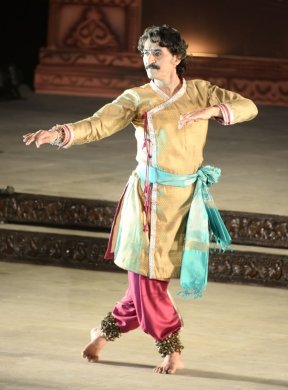 Rajendra Gangani As for the Kathak program which followed, it seemed that Rajendra Gangani had treated the event featuring his students from Guru Kundanlal Gangani Foundation, rather lightly. One is not against Chhand/laya/Gati in Kathak, which comprises a predominant element of nritta virtuosity as part of its identity. But what was presented lacked any choreographic designing. And on a platform devoted to ensemble presentations, the Guru embarked on a solo depiction in teentaal! Rubbing the pointed big toe on the ground to produce that special ghungroo sound and Guru Kundanlal Gangani's special ‘Thaat' and Jugalbandis with the tabla are known. For an occasion like this festival, one needs a less casual approach to programming. The female students in a circle providing glimpses of abhinaya, or male dancers with each presenting a tukra demonstrating in the process, different types of chakkars was more like classroom fare - and I do believe that aside from the open ended khulla Kathak presentation, something of a more organised nature is expected from the gurus for such festivals. And the sur lacking music did not help. 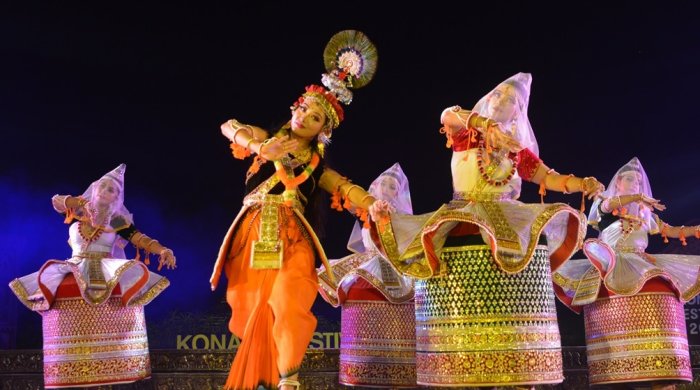 Jawaharlal Nehru Manipuri Dance Academy Manipuri grace in its exquisite slowness and graceful serenity of face, unruffled by the contours of mukhabhinaya, comes across with an almost hypnotic mesmerising spirituality - which one felt watching the dancers from Jawaharlal Nehru Manipuri Dance Academy from Imphal. A short glimpse of Lai Haraoba maibis dancing, followed by Vasant Ras represented the central point of Manipur's dance culture - wherein the ancient worship of evoking an abstract divinity, on which was imposed Vaishnavism with its anthropomorphic worship to Krishna, has existed in togetherness - each strain thriving in its fullest expression, without enmity. The high costuming aesthetic, and the performances ending with Krishna on a full moonlight dancing with the Gopis in the kunj held the large audience spellbound. The soulful vocalist along with the pung percussion made for wonderful music. 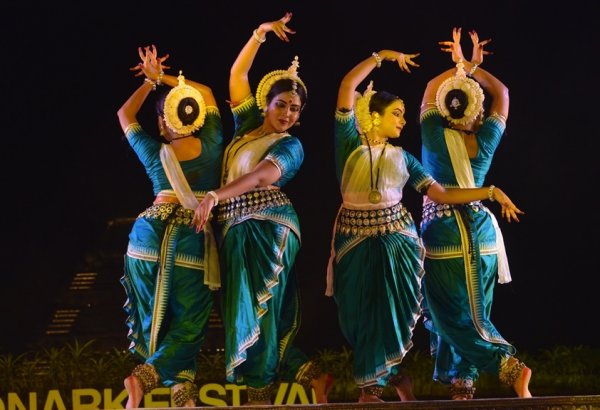 Meera Das group The second half of the evening had Meera Das with her dancers from Gunjan Academy in a programme conceived by Kedar Mishra, starting with an invocation addressed to the Sun God. Replete with well held frozen group images contrasting with rigorous movements of Surya piloting his chariot with seven powerful horses, it was followed by a Pallavi in raag Jhinjhoti set to Ektali. The concluding presentation was built round the theme of struggling womanhood - a very significant but by no means rare subject, being treated in all genres of art, including dance. Based on a poem of Vyas Kabi Fakirmohan Senapati, juxtaposed by poems of Ramakanth Rath and Kedar Mishra, Meera's treatment dipped into the known heroines from Indian mythology like Sita, Draupadi, Radha, including the woman of today with episodes like bride burning, acid throwing and Nirbhaya providing plenty of grist for the choreographic mill. Srinibas Satpathy, the talented flute player, was the music composer. Meera has a feel for choreography and the passing scenes communicated in explicit brevity. But one wondered if Radha, a married woman, losing her heart and soul in the Krishna search, could be considered as being sinned against! Her search for completeness was at a different level, and strictly for me, she cannot be a subject providing an example of deprived womanhood. Somewhere one smelt shades of an earlier work by choreographer/dancer Aruna Mohanty, again with Kedar Mishra's poetic inputs. 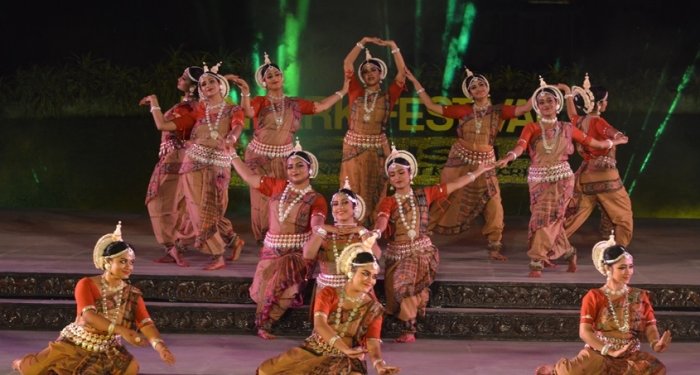 Debamitra Sengupta and group Many Odissi groups have a penchant for filling the stage with a large group of eighteen to twenty dancers - thereby cutting out the empty spaces that can be filled with the energy of dancing bodies, which is what produces the fire of communicating with the audience. Debamitra Sengupta with Mayur Lalit Dance Academy, her group from Kolkata, was one such, starting with Numo Bharatam, an Ode to the Motherland, which lives by the dictum of Ekameva Jayate of universality through diversity. Well trained dancers in rather crowded formations representing India, performed to the Sanskrit script by Pandit Nityananda Mishra dancing to the music of Dr. Bijay Kumar Jena, to the rhythm set by Bijay Barik. The Pallavi in Malkauns which followed, again had far too many dancers crowding the stage, all stationary in their respective places, with no movements covering stage space, while keeping rhythm to Satchidananda Das' Aadi taal setting, making the item look like a pure postural change of bhangis. The beauty of creating formations on stage was lost, the treatment lack lustre despite postural correctness in the dancers. The histrionic element came in during the finale, in Nayanaarpanam, an episodic treatment of an excerpt based on Krittibas Ramayana of Bengal, built round the unseasonal Akal Bodhon of Sri Rama's Durga Puja in the time of autumn. Praying for strength to overpower Ravana, Rama, evoking Mahishasuramardini, through an offering of Ashtotram requiring 108 lotus flowers, ran short of one flower. In a bid to offer his own lotus eyes to make up for the loss, he was stopped by the Goddess, who appeared and blessed him with victory in the battle against Ravana - accomplishing in the process, Ravana's desire that he attain moksha, with his end being at the hands of Vishnu. Parts of the presentation were extremely well thought out. One wished the music with the high pitched, less than sur perfect singing, had been different. Having worked at creating a large repertory of trained students, Debamitra, with maturing choreographic ideas over time, can look to a promising future. 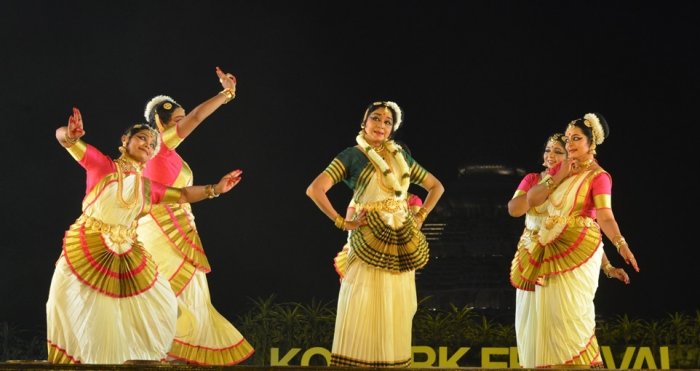 Gopika Varma and group Mohiniattam dancer Gopika Varma, has over the years presented interesting fare with her Dasyam Centre students. One felt she could have reduced the excess of dramatized work in this festival, for some more dance reflective of the graceful torso swirl of the Mohiniattam technique, which one found very little of. The invocation to the lotus eyed Gajamukhadeva Ganapati in Paramananda Natana described in his ekadanta, vamana roopa, modaka hasta glory, based on a composition of Maharaja Swati Tirunal in raga Kedaram, choreographed by Guru Kalamandalam Sugandhi and Gopika Varma, made for a soft, graceful start, with some nritta. This was followed by another Swati Tirunal composition "Aaj aaye Shyam Mohan" in Mishra Pahadi, again Gopika Varma's choreography, wherein Krishna's Raas Leela play with the Gopis, was more of love sport than nritta. And the concluding Aadi Shankaracharya composition Bhaja Govindam, on the purposelessness of coveting possessions, when life with punarapi jananam punarapi maranam, is a constant churn from birth to death, is all philosophy - and despite delicate mukhabhinaya by Gopika and the students, the entire programme became largely mimetic and may well have pertained to any other dance tradition - but for the getup of the dancers. Pity, since the last item was an interesting Nindastuti wherein the wives of Shiva and Vishnu namely Parvathi and Lakshmi, have an altercation - each pin-pointing the other's husband, for deemed misdemeanours (like Shiva secretly harbouring Ganga in his locks) - again theatre with little nritta. Full of humour as it was, and an unusual finale, few could understand it, because the compering, both in Oriya and Hindi/English, somehow missed introducing the item. Sadly it was one of those days when the singer was appallingly offkey, totally unable to find sruti alignment.  Leela Samson's Spanda Dance Company Leela Samson's Spanda Dance Company took the place by storm with their Bharatanatyam proficiency. Just seven finished dancers, brimming with sparkle and communicative energy, were more than enough to fill the three levels of the vast performance space. Right from the sizzling Vinayaka invocation Tandava Nrityakari Gajanana, a composition of Tirugokaranam Vaidyanatha Bhagavatar, to the finale it was a spell binding recital. The constantly changing formations portraying the dance of Nataraja, the greatest metaphor of Indian thought, the immaculate technique, choreographer Leela Samson's imaginative dance designing with skilful dramatization of scenes with nothing overdone, like the smooth spin- off narrating Shiva's deep penance ending in Manmatha dahana, in the Swati Tirunal composition Shankara Srigiri in raga Hamsanandi describing Shiva's dance in the Chitra sabha, with Bhringi and other bhutaganas, as celestials and ascetics rejoicing in playing instruments, the group interpretation spoke of painstaking preparation, with no half measures. While sharing stage space, each dancer revealed total inner involvement, without which mere group aesthetics will not bring out the full effect of a production. The one flaw noticed was the slight lack of balance in a couple of dancers while standing in the one legged poses - held over a whole avarthanam! The next item, full of verve, Atishaya, built on Purandara Dasa's composition, Adidanu Ranga, set to raag Charukesi and Hamsanandi by music composer Rajkumar Bharati, was woven round Krishna's feat in subjugating the poisonous snake Kalinga in the Jamuna and then dancing on its hood. The troupe concluded with a Lalgudi Jayaraman Tillana in Madhuvanti. Contributing in no small measure to the total effect was the sur filled music - balm for ears bombarded by indifferent melodic accompaniment in many of the programmes. From the start with the violin overture of Easwar Ramakrishnan, to the sonorous flute of Sujith Nayak, it was melody casting a spell. And what dulcet singing by Binu.V.Gopal! This wing support was a true example of how nritta support provided by Nattuvangam by Aadith Narayan and percussion on the mridangam by Vedakrishnaram, can be so full of musicality. 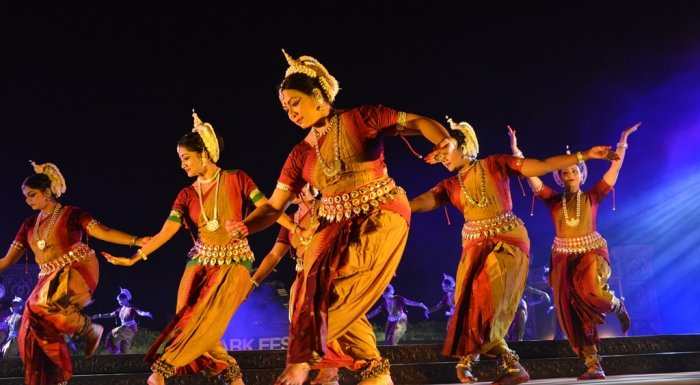 Suravi ensemble Having to take the stage after such a high grade performance, would have been a mammoth task for any troupe. If Pitambar Biswal's dancers from Suravi failed to live up to the task, it was hardly surprising. A large troupe of twenty dancers, apart from crowding the performance area, comprised a mixed group, not all the best of dancers, in technique or stage presence. Shunya Brahmananda, the opening number on the subject of nothingness or void requiring highly sensitised interpretation in the language of dance, was substituted with a very literal, simplistic image of Vishnu creating Lord Brahma for creation and Lord Shiva for ‘destruction of all evils' as it was announced - which was neither here nor there. The image which stood out was of Vishnu reclining on the Naga couch with Lakshmi pressing his legs! Male chauvinism at its peak! The idea of the void remained unclear. And in the dramatic second half based on Guru Ramarao Patro's script with music composition by Himanshu Shekhar Swain, based on Mathura Mangala describing Akrura's arrival in Gopapura to escort brothers Krishna and Balarama to Mathura, as per the orders of King Kamsa, the Gopis (with whom the long interaction of Akrura is mentioned in many texts), Yashoda, Radha, Gopis were all bunched in a dialogue which, in confused communication, did not reveal any creative imagination in the choreography. And the quality of the shrill offkey singing left a lot to be desired. 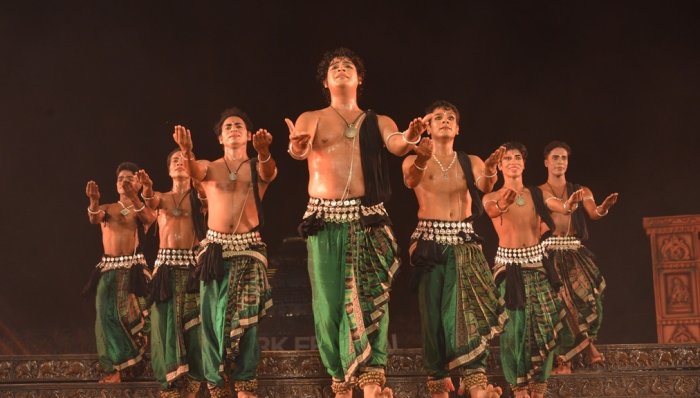 Pravat Kumar Swain and group On the last evening, Nrutya Naivedya's presentation choreographed by young dancer Pravat Kumar Swain, was one of the best among the Odissi presentations. Starting with an arresting Surya Bandana scripted by Pt. Nityananda Mishra, with music in a Ragamalika form scored by Sukant Kundu and rhythm in matching Taalamalika set by Bijay Kumar Barik, the group image of the Sun God driving his chariot of five horses, exploded on the stage in full power. The group of excellently trained dancers, who held themselves so well, truly made the Pallavi, a musical creation of Sukant Kundu again, in raag Bakulabharana, with Dhaneswar Swain's rhythmic inputs blossom out in a rhythmic tapestry, starting slow and increasing in tempo towards the end. Even while the Guru and choreographer was away on another assignment, the dancers have to be lauded for performing in smooth precision. The last work Sada Ripu, through examples taken from the epics, showed how man for the attainment of bliss, had to conquer the evils of kama, krodha, lobha, moha, mada, matsarya. Incisively communicative, sans needless stretching out and padding, narrative sequences followed - Keechaka's lust for Draupadi, Hiranyakashipu's arrogance with Narasimha emerging out of the smashed pillar to rescue his devotee Prahalad, Kaikeyi destroyed by ambitions for her son, Dasaratha's infatuation for Kaikeyi resulting in his sudden death with no son beside him and Yudhisthira's weakness for gambling, leading to wife Draupadi's humiliation and finally the Kurukshetra war. Pravat Kumar Swain's is an exceptional talent. Following a very just motto that a significant government festival sponsoring all dance forms, needs to give prime encouragement to its home grown tradition of Odissi, does force certain compulsions on the festival committee. Given the present stipulation of not allowing any group to be supported more often than once in three to four years, finding really finished local groups for a daily Odissi slot in the festival is difficult, and is leading to compromising on standards. In such a situation, an artiste like Pravat Kumar Swain holds out great hope for Odissi's future, for his excellent teaching credentials, which can groom many youngsters for the future of Odissi. 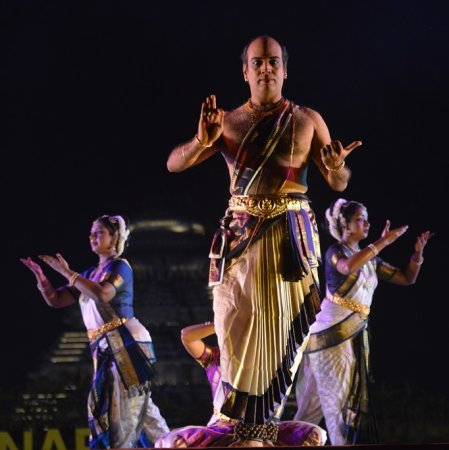 Jaikishore Mosalikanti and group One of the senior most disciples of late stalwart Vempati Chinna Satyam, Jaikishore Mosalikanti's art passed on to students of his institution Shivamohanam in Chennai is unalloyed, vintage Kuchipudi. After an invocation to Ganapati through the composition Pranavakaram siddhi vinayakam in raga Arabhi came the natya, nritta and nritya in the Tarangam Shiva Shiva Bhava Bhava Sharanam in Ragamalika choreographed by Jaikishore Mosalikanti, woven round the descent of the Ganga. As a metaphor of the moving universe, Shiva is coeval with the five elements. While Mosalikanti with his height came in handy as Shiva covering the body of descending Ganga with only her face appearing above his head, more creative lighting effects, would have helped. It concluded with group uniformity, all the six dancers dancing in a line, with feet planted on the rim of a brass plate. The finale was a Tillana in Ragamalika based on a composition of late Balamuralikrishna. Composed in five ragas with Kalyani as the base - Shankarabharanam, Mohanam, Hindolam, Darbari Kanada. Balamurali's compositions, very different from the usual run of songs, in the sruti bedham as changes usher in raga to raga, can pose problems for the musicians. But this was extremely well handled. The vocalist Sweta Prasad provided unfaltering tuneful support right through. Nattuvangam by Aadith Narayan, flute by Sujith Naik, mridangam by Ram Shankar Babu and violin by Easwar Ramakrishnan made for soothing musical support. Alongside was the Sand Art Festival on the beach attracting sizeable crowds. The compering in Oriya and Hindi/English is a very important aspect of a festival broadcast to all parts of the country. Both in terms of sound management and in terms of how to the-point with clarity the announcements are, this year's twosome, while individually experienced, showed less of the sparkle and coordination of the past.  Writing on the dance scene for the last forty years, Leela Venkataraman's incisive comments on performances of all dance forms, participation in dance discussions both in India and abroad, and as a regular contributor to Hindu Friday Review, journals like Sruti and Nartanam, makes her voice respected for its balanced critiquing. She is the author of several books like Indian Classical dance: Tradition in Transition, Classical Dance in India and Indian Classical dance: The Renaissance and Beyond. Response * Such a beautiful and a memorable event plus this writeup by Ms Leela has enhanced the Konark Dance Festival. I wish to attend again in the near future. Thank you very much. (Dec 20, 2022) Post your comments Pl provide your name and email id along with your comment. All appropriate comments posted with name and email id in the blog will also be featured in the site. |